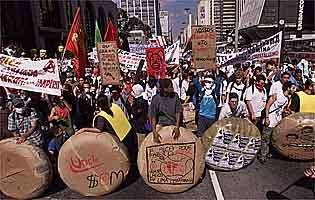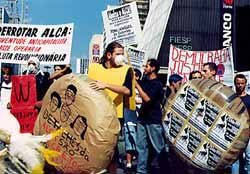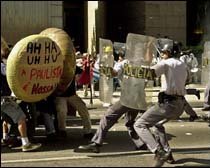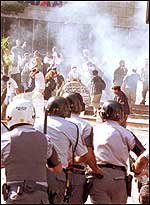
 |
At noon today approximately 600 Brazilian anti-capitalist activists converged on the steps of the Gazeta building on Avenida Paulista, the financial centre of São Paulo, for a demonstration against the FTAA. Less then two hours later, the group was violently repressed and dispersed by heavily armed military police.
Today is A20 - Day of Global Action Against Capitalism, an international day of solidarity against the Summit of Americas now convening Quebec City, meeting now to negotiate the FTAA.
The São Paulo demonstration, titled by organizers Carnival Against the FTAA brought together hundreds of protestors (exact numbers unavailable as of still). A percussion band played, while activists danced, juggled, sang, chanted and blew whistles. Banners and waves were flown, while frowning masks representing various Latin American countries were hoisted alonside the grinning face of the United States.
 |
Evidence of the anticipation of violence emerged when some demonstrators arrived bearing colourfully decorated shields constructed out of carboard, masking tape and tires.
Barring the brief appearance of a small CUT (Central Workers'Union) delegation, the demonstration was void of party or union support. Organizers described the event as organized completely horizontally and based on five principles: anti-capitalism, commitment to direct action, organization based on direct democracy, decentralized authority, and creativity.
The majority of those present were young students and activists. Among them were also journalists, a few lawyers and 'legal observers', present to ensure that rights of protestors were maintained. Flyers distributed included consice information about the rights of the protestor as guaranteed by Brazil's federal constitution, and "what to do in case of arrest".
 |
The march began peacefully, with demonstraters walking along the largely blocked avenue, stopping briefly to chant at strategic points including Itau bank and a petroleum station.
Violence erupted soon after, when a young protestor was beaten with police batons. The protestor, emerged from the comotion, bleeding profusely from injuries incurred to his head, to speak with journalists. When ask to defend the police attack, one officer offered by way of excuse, that the young man had been seen hitting a police car.
The violence soon escalated as police attempted to disperse the demonstration with tear gas and charging. Protestors were charged by police repeatedly. Those who did not run or did not run fast enough were beaten, often from behind, with police batons. Amid the chaos several injured men and women, clothes stained with blood, could be seen walking the streets visibly shaken.
 |
After the arrest of at least 2 protestors, one wearing a gas mask, the demonstration reconvened at the Central Bank of Brazil, the march's final destination, where organizers hoped to demand an audience with the bank's president to present him with a 3 foot envelope containing the message: "FTAA - no fucking way." But despite their large presence, protestors could not enter the building which was gaurded behind locked doors by approximately 10 security gaurds. Taking their cue from this, many shop owners and magazine stand operators along the march 's path also closed and gated their doors.
Riot police were called in and violence continued to rage and with more tear gas, chargings and beatings, police managed to disperse the crowd - both on the street and in front of the Central Bank of Brazil. Numbers of those injured are not yet available, but the seriousness appeared grave. And long after the chaos subsided, police continued to charge, the scattered protestors and confused pedestrians alike, while helipcopters hovered above.
Information is only now coming in about those arrested. One source sites that over 60 people are now detained and remain in two police stations without legal representation.
An unidentified number of protestors are also awaiting assistance in neighboring hospitals.
One demonstrator, complaining of the scale of violence, stated that the repression was completely unecessary describing that "the initial idea of the demonstration was a peaceful one where people could express themselves freely with music and theatre."
Another participant from the city of Baixada Santista and representative of the collective "Green Alternative" described how organizers had yesterday communicated with São Paulo's city hall, informing them of today's manifestation. According to him, demonstrators were constitutionally guaranteed the right to gather and demonstrate today, and as long as authorities are duely notified, permission or warrants do not need to be issued.
One journalist commented that today's violence while extreme, was not alltogether unexpected. He sited the massive university strike of last August, where a large group of demonstrators, marching along Avenida Paulista were also met with violent police repression. "If police beat up professors, they're certainly not going to have any problems attacking punks" he explained.
Just two hours after the dispersion of the demonstration, Avenida Paulista has resumed its normal rush hour activity. The only evidence of today's events which remain is the shattered glass outside a McDonalds store, an Itau bank and the Central Bank of Brazil - locations targeted by several demonstrators after the outbreak of police violence.
And over the main sign outside the Central Bank of Brazil the following words are spraypainted: "The People Don't Want ALCA".
